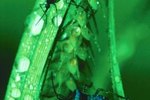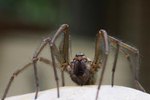
According to New Mexico State University, the southwestern state of New Mexico is home to more than 1,000 spider species. While every spider is capable of biting and injecting venom, most of them are harmless. Their fangs are too small and their venom is too limited to cause more than swelling, irritation and itching. However, there are two genera of spiders in New Mexico that are considered dangerous.
Widow Spiders (Latrodectus)
Two species of widow spiders are found in New Mexico, according to Venombyte.com. Only female widows are considered dangerous. The western black widow (Latrodectus hesperus) is glossy black, adorned with a red hourglass shape on the underside of its abdomen. The brown widow (Latrodectus geometricus) varies from cream to dark brown and is adorned with an orange or yellow hourglass. Widows are not aggressive, but will bite if handled or threatened, especially if an egg sac is present. They typically build their webs in areas that sit undisturbed for periods of time, like sheds, dormant lawn equipment, patio furniture, garages, basements, crawl spaces and under decks.
Recluse Spiders (Loxosceles)
Five species of recluse spiders have been found in New Mexico. The Apache (Loxosceles apachea), Arizona (Loxosceles arizonica), desert (Loxosceles deserta), and blanda or Big Bend (Loxosceles blanda) are long-established residents. The brown recluse (Latrodectus reclusa) is newly reported in the city of Roswell, according to New Mexico State University. Recluse spiders are often called violin or fiddleback spiders because of the violin-shaped mark on their backs, although not every recluse spider has this defining characteristic. They vary in color from yellow-tan to brown, and possess six eyes arranged in three pairs of two. They typically live under dead cacti, logs, rocks or other debris.
The Venom
Widow spiders inject a neurotoxin that travels through the bloodstream and attacks the nervous system. Varying degrees of pain occur, eventually localizing in the abdomen and back. Symptoms include cramping, nausea, fever, perspiration, tremors, restlessness, elevated blood pressure and respiratory distress. Death occurs in 5 percent of all widow bite cases. The venom of recluse spiders contains necrotizing enzymes. The bite sight immediately swells and hardens. If left untreated, the bite will progress to a painful, ulcerated wound that can take months to heal. Recluse venom can cause organ damage and even death, but this is very rare. If a widow or recluse bite is suspected, medical attention should be sought immediately, and if at all possible, the offending spider or its remains should be brought in for testing.
Prevention
The New Mexico Poison and Drug Information Center recommends you be proactive in the prevention of spider bites. Dust and vacuum your home regularly, especially in corners, crevices, around windows and under furniture. Keep the inside and outside of your home clear of clutter and debris, and never stack wood close to your house. Wear gloves when you work outdoors, particularly when handling rocks, wood piles, brush and dormant lawn equipment. Have your home and yard professionally treated for poisonous spiders -- just make sure the pesticide is safe for children and pets.
References
Resources
Photo Credits
-
Photos.com/Photos.com/Getty Images
Writer Bio
Yvette Sajem has been a professional writer since 1995. Her work includes greeting cards and two children's books. A lifelong animal advocate, she is active in animal rescue and transport, and is particularly partial to senior and special needs animals.




